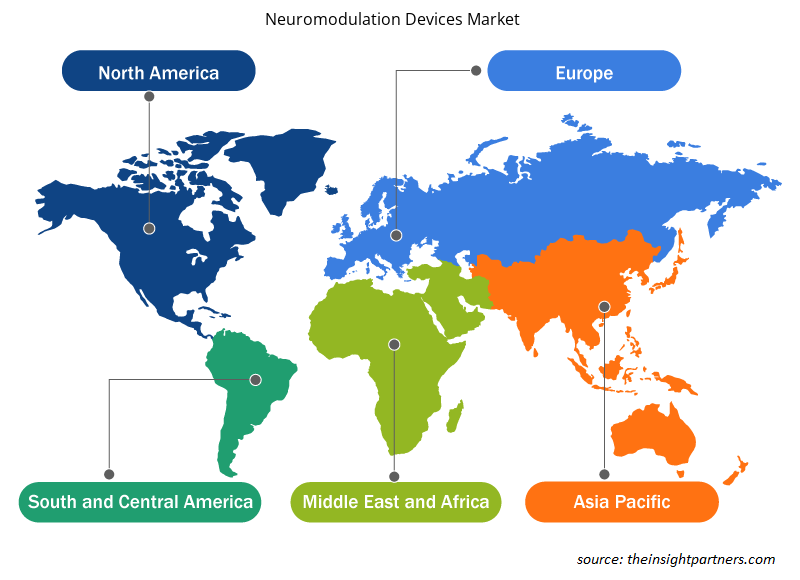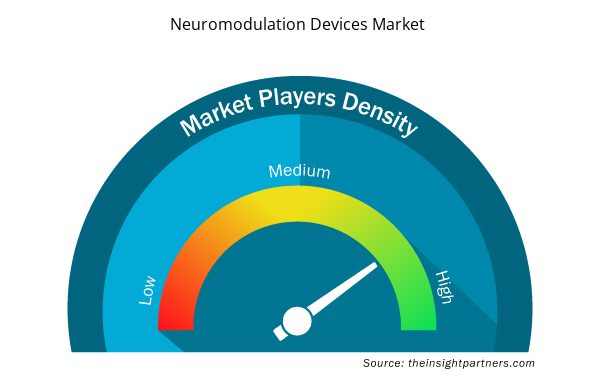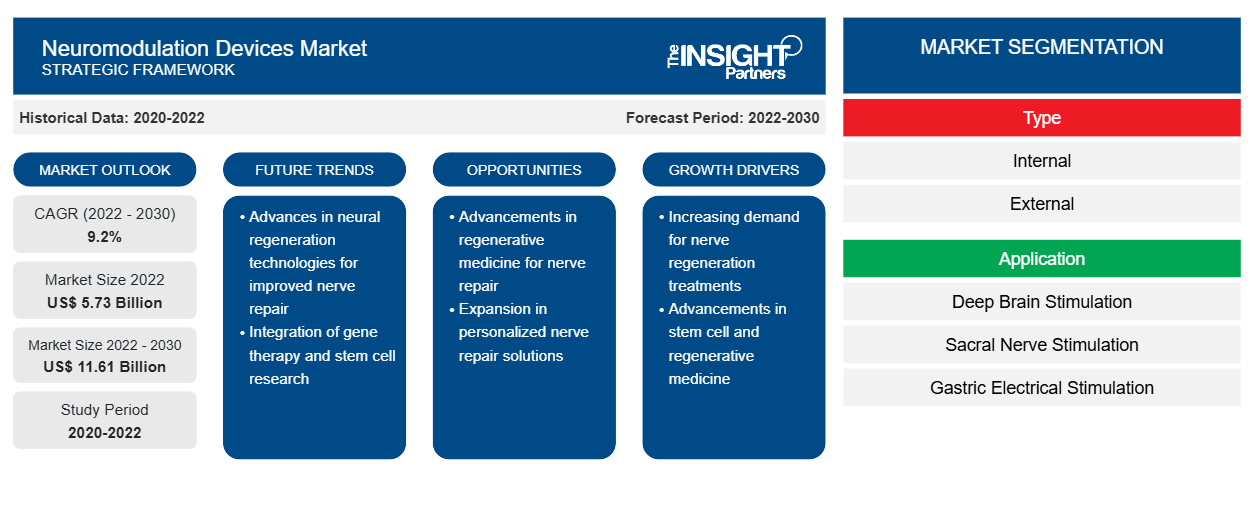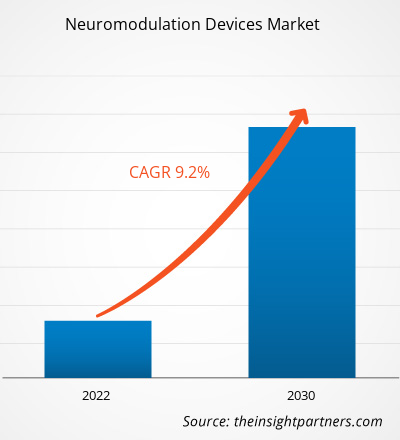[Forschungsbericht] Der Markt für Neuromodulationsgeräte wurde im Jahr 2022 auf 5,73 Milliarden US-Dollar geschätzt und soll bis 2030 11,61 Milliarden US-Dollar erreichen. Der Markt dürfte von 2022 bis 2030 eine durchschnittliche jährliche Wachstumsrate (CAGR) von 9,2 % verzeichnen.
Markteinblicke und Analystenansichten:
Der Bericht enthält Wachstumsaussichten sowie die aktuellen Markttrends für Neuromodulationsgeräte und ihre vorhersehbaren Auswirkungen während des Prognosezeitraums.
Die Anwendung von Neuromodulation nimmt rasant zu und es gibt eine breite Palette implantierbarer und nichtinvasiver technologiebasierter Methoden zur Behandlung neuropsychiatrischer und neurologischer Störungen. Therapien wie intrakranielle Kortexstimulation (ICS), transkranielle Magnetstimulation (TMS), tiefe Hirnstimulation (DBS) und transkranielle Gleichstromstimulation (tDCS) haben bei einer Reihe neuropsychiatrischer und neurologischer Störungen vielversprechende Ergebnisse gezeigt. Neuromodulationsgeräte sind fortschrittliche medizinische Instrumente, die die Aktivität des Nervensystems anpassen können. Die Technologie wird zur Behandlung von Bewegungsstörungen wie Dystonie, Parkinson-Krankheit, Tremor, Tinnitus, Zwangsstörungen, sensorischen Behinderungen, Epilepsie, Blasenkontrolle, Kopfschmerzen, chronischen Schmerzen, Schlaganfall, minimalem Bewusstseinszustand, Spastik und Rückenmarksverletzungen eingesetzt. Faktoren wie die steigende Zahl von Rückenmarksverletzungen und die zunehmende Verbreitung neurologischer Störungen tragen zum wachsenden Markt für Neuromodulationsgeräte bei.
Markttreiber:
Die geriatrische Bevölkerung ist anfällig für neurologische Erkrankungen. Häufige neurologische Erkrankungen, die ältere Menschen betreffen, sind Neuropathie, Parkinson-Krankheit, Alzheimer-Krankheit, Dystonie und andere. Nach Angaben des Wirtschafts- und Sozialministeriums der Vereinten Nationen gab es im Jahr 2022 weltweit 771 Millionen Menschen im Alter von 65 Jahren und älter. Es wird erwartet, dass die ältere Bevölkerung bis 2030 994 Millionen und bis 2050 1.600 Millionen erreichen wird. Länder wie die USA und Kanada weisen hohe Prävalenzraten von Bewegungsstörungen und psychiatrischen Störungen auf, die mit der wachsenden geriatrischen Bevölkerung verbunden sind. Laut der Parkinson-Stiftung treten Parkinson-Symptome im Durchschnittsalter von 60 Jahren häufig auf.
Laut der Canadian Psychological Association leiden etwa 2 % der Bevölkerung Kanadas an Zwangsstörungen. Laut der Weltgesundheitsorganisation (WHO) ist Epilepsie eine neurologische Erkrankung, die Anfälle verursacht und weltweit etwa 50 Millionen Menschen betrifft. Laut der American Academy of Neurology ist Schlaganfall die dritthäufigste Todesursache in den USA, gefolgt von Alzheimer als sechsthäufigster Todesursache. Statistiken aus derselben Quelle zeigen, dass fast eine Million Amerikaner an Parkinson leiden und jedes Jahr mindestens 60.000 neue Fälle gemeldet werden. Die zunehmende Verbreitung neurologischer Erkrankungen in Verbindung mit lebensstilbedingten Störungen wie Depressionen und chronischen Schmerzen führt zu einer zunehmenden Nutzung technologisch fortschrittlicher Produkte.
Daher sind die steigende Anzahl an Patienten mit einer Neigung zu neurologischen Erkrankungen im geriatrischen Bevölkerungskreis, die zunehmende Verbreitung dieser Erkrankungen und das wachsende Bewusstsein hinsichtlich der enormen Belastung durch neurologische Störungen die Wachstumstreiber auf dem Markt für Neuromodulationsgeräte.
Die Neurowissenschaft konzentriert sich auf die Behandlung von Erkrankungen wie Schlaganfall, Kopfschmerzen, Multipler Sklerose und anderen schweren Fällen. In den letzten Jahren wurde selbst in Industrieländern ein relativer Mangel an qualifiziertem neurologischem Personal beobachtet. In den USA gibt es über 5.700 Krankenhäuser, in denen jedoch weniger als 3.700 Neurochirurgen arbeiten. Ein wichtiger Faktor, der für den Mangel an neurochirurgischem Personal verantwortlich ist, ist die Unfähigkeit, ausreichend ausgebildete Neurochirurgen in angemessener Zeit auszubilden. In städtischen Gebieten gibt es neurologische Einrichtungen mit fortschrittlicher Technologie. In ländlichen Gebieten werden jedoch aufgrund des Mangels an Fachpersonal nur begrenzte Behandlungen angeboten. Daher behindert der Mangel an qualifizierten Neurochirurgen das Wachstum des Marktes für Neuromodulationsgeräte.
Passen Sie diesen Bericht Ihren Anforderungen an
Sie erhalten kostenlos individuelle Anpassungen an jedem Bericht, einschließlich Teilen dieses Berichts oder einer Analyse auf Länderebene, eines Excel-Datenpakets sowie tolle Angebote und Rabatte für Start-ups und Universitäten.
- Holen Sie sich die wichtigsten Markttrends aus diesem Bericht.Dieses KOSTENLOSE Beispiel umfasst eine Datenanalyse von Markttrends bis hin zu Schätzungen und Prognosen.
Berichtssegmentierung und -umfang:
Die „Marktanalyse für Neuromodulationsgeräte“ wurde unter Berücksichtigung der Segmente Typ, Anwendung, Biomaterial und Endbenutzer durchgeführt.
Segmentanalyse:
Der Markt für Neuromodulationsgeräte ist nach Typ in externe und interne unterteilt. Das Segment der internen Neuromodulation hatte 2022 einen größeren Marktanteil an Neuromodulationsgeräten. Das Segment der externen Neuromodulation dürfte jedoch zwischen 2022 und 2030 eine höhere CAGR verzeichnen. Der Begriff „interne Neuromodulation“ beschreibt die Verwendung von medizinischen Geräten, die elektrische, chemische oder andere Formen der Stimulation für bestimmte neuronale Ziele bereitstellen, um die Aktivität des Nervensystems zu modulieren oder zu verändern. Diese Technik wird zur Behandlung von neurovaskulären Erkrankungen, Bewegungsstörungen, Epilepsie, chronischen Schmerzen sowie Stuhl- und Harninkontinenz eingesetzt.
Nach Endverbraucher ist der Markt für Neuromodulationsgeräte in Krankenhäuser, Kliniken und häusliche Pflege unterteilt. Im Jahr 2022 dominierte das Krankenhaussegment den Marktanteil der Neuromodulationsgeräte. Aufgrund der Expansion zahlreicher Krankenhäuser und Kliniken und erhöhter staatlicher Ausgaben für den Aufbau der Gesundheitsinfrastruktur dominiert das Krankenhaussegment derzeit den Markt. Darüber hinaus wird erwartet, dass die alternde Bevölkerung zu einer höheren Prävalenz chronischer Schmerzen führt, was die Nachfrage nach Neuromodulationsgeräten in Krankenhäusern ankurbelt.
Regionale Analyse:
Der Umfang des Marktberichts zu Neuromodulationsgeräten ist hauptsächlich in Nordamerika (USA, Kanada und Mexiko), Europa (Spanien, Großbritannien, Deutschland, Frankreich, Italien und das übrige Europa), den asiatisch-pazifischen Raum (Südkorea, China, Indien, Japan, Australien und den übrigen asiatisch-pazifischen Raum), den Nahen Osten und Afrika (Südafrika, Saudi-Arabien, die Vereinigten Arabischen Emirate und den übrigen Nahen Osten und Afrika) sowie Süd- und Mittelamerika (Brasilien, Argentinien und den übrigen Süd- und Mittelamerika) unterteilt.
In Bezug auf den Umsatz dominierte Nordamerika im Jahr 2022 den Marktanteil bei Neuromodulationsgeräten. Die zunehmende Verbreitung neurologischer Erkrankungen, hohe Ausgaben für Forschung und Entwicklung, die steigende Zahl von Produktzulassungen durch die FDA und der technologische Fortschritt steigern die Nachfrage nach Neuromodulationsgeräten in der Region.
Regionale Einblicke in den Markt für Neuromodulationsgeräte
Die regionalen Trends und Faktoren, die den Markt für Neuromodulationsgeräte während des Prognosezeitraums beeinflussen, wurden von den Analysten von Insight Partners ausführlich erläutert. In diesem Abschnitt werden auch die Marktsegmente und die Geografie von Neuromodulationsgeräten in Nordamerika, Europa, im asiatisch-pazifischen Raum, im Nahen Osten und Afrika sowie in Süd- und Mittelamerika erörtert.

- Erhalten Sie regionale Daten zum Markt für Neuromodulationsgeräte
Umfang des Marktberichts zu Neuromodulationsgeräten
| Berichtsattribut | Details |
|---|---|
| Marktgröße im Jahr 2022 | 5,73 Milliarden US-Dollar |
| Marktgröße bis 2030 | 11,61 Milliarden US-Dollar |
| Globale CAGR (2022 - 2030) | 9,2 % |
| Historische Daten | 2020-2022 |
| Prognosezeitraum | 2022–2030 |
| Abgedeckte Segmente | Nach Typ
|
| Abgedeckte Regionen und Länder | Nordamerika
|
| Marktführer und wichtige Unternehmensprofile |
|
Marktteilnehmerdichte für Neuromodulationsgeräte: Auswirkungen auf die Geschäftsdynamik verstehen
Der Markt für Neuromodulationsgeräte wächst rasant, angetrieben durch die steigende Nachfrage der Endnutzer aufgrund von Faktoren wie sich entwickelnden Verbraucherpräferenzen, technologischen Fortschritten und einem größeren Bewusstsein für die Vorteile des Produkts. Mit steigender Nachfrage erweitern Unternehmen ihr Angebot, entwickeln Innovationen, um die Bedürfnisse der Verbraucher zu erfüllen, und nutzen neue Trends, was das Marktwachstum weiter ankurbelt.
Die Marktteilnehmerdichte bezieht sich auf die Verteilung der Firmen oder Unternehmen, die in einem bestimmten Markt oder einer bestimmten Branche tätig sind. Sie gibt an, wie viele Wettbewerber (Marktteilnehmer) in einem bestimmten Marktraum im Verhältnis zu seiner Größe oder seinem gesamten Marktwert präsent sind.
Die wichtigsten auf dem Markt für Neuromodulationsgeräte tätigen Unternehmen sind:
- Abbott (St. Jude Medical, Inc.)
- LivaNova PLC
- Boston Scientific ist eine gemeinnützige Organisation, die sich auf die Förderung von Wissenschaft und Technologie spezialisiert hat. Sie ist die erste in den USA und hat 19
- Aleva Neurotherapeutics SA
- Bioventus
Haftungsausschluss : Die oben aufgeführten Unternehmen sind nicht in einer bestimmten Reihenfolge aufgeführt.

- Überblick über die wichtigsten Akteure auf dem Markt für Neuromodulationsgeräte
Wettbewerbslandschaft und Schlüsselunternehmen:
Der Marktbericht zu Neuromodulationsgeräten konzentriert sich auf prominente Akteure auf dem Markt wie Abbott (St. Jude Medical, Inc), LivaNova PLC, Boston Scientific Corporation, Aleva Neurotherapeutics SA, Bioventus, EnteroMedics Inc, Nevro Corporation, NeuroPace Inc, Synapse Biomedical Inc und Neurosigma Inc. Die Marktprognose für Neuromodulationsgeräte kann den Beteiligten bei der Planung ihrer Wachstumsstrategien helfen. Diese Unternehmen konzentrieren sich auf neue Technologien, die Verbesserung bestehender Produkte und Markterweiterungen, um die wachsende Verbrauchernachfrage weltweit zu erfüllen. Laut Pressemitteilungen der Unternehmen sind im Folgenden einige aktuelle Schlüsselentwicklungen aufgeführt:
- Im August 2023 erhielt Medtronic plc die CE-Kennzeichnung für seinen wiederaufladbaren Rückenmarkstimulator (SCS) Inceptiv mit geschlossenem Kreislauf. Es ist das erste SCS-Gerät von Medtronic, das über eine Closed-Loop-Funktion verfügt, die die individuellen biologischen Signale jeder Person erfasst und die Stimulation je nach Bedarf von Moment zu Moment anpasst, um die Therapie im Einklang mit den Bewegungen des täglichen Lebens zu halten.
- Im August 2023 erhielt Abbott von der US-amerikanischen Food and Drug Administration (FDA) die Zulassung für sein neues Rückenmarkstimulationssystem (SCS) Proclaim Plus mit FlexBurst360-Therapie. Die FlexBurst360-Therapie, die nächste Generation der proprietären BurstDR-Stimulation von Abbott, bietet Schmerzabdeckung in sechs Bereichen des Rumpfes und/oder der Gliedmaßen. Sie ermöglicht eine Programmierung, die an die therapeutischen Bedürfnisse einer Person angepasst werden kann.
- Historische Analyse (2 Jahre), Basisjahr, Prognose (7 Jahre) mit CAGR
- PEST- und SWOT-Analyse
- Marktgröße Wert/Volumen – Global, Regional, Land
- Branche und Wettbewerbsumfeld
- Excel-Datensatz



Report Coverage
Revenue forecast, Company Analysis, Industry landscape, Growth factors, and Trends

Segment Covered
This text is related
to segments covered.

Regional Scope
North America, Europe, Asia Pacific, Middle East & Africa, South & Central America

Country Scope
This text is related
to country scope.
Häufig gestellte Fragen
The neuromodulation device market, based on end user, segmented into hospitals, clinics, and home healthcare. In 2022, the hospitals segment dominated the neuromodulation devices market share.
Asia Pacific is expected to be the fastest growing region in the neuromodulation device market. The rising prevalence of neurological diseases and the development of neuromodulation devices are likely to enhance the market's growth in the coming years. China is among the most populated countries in the world, and the country has a maximum number of patients suffering from neurological disorders.
The neuromodulation device market, based on application, is segmented into metallic, polymeric, and ceramic. In 2022, the metallic segment dominated the market share. However, the polymeric segment is likely to register the highest CAGR during 2022–2030.
The neuromodulation device market, based on application, is segmented into deep brain stimulation (DBS), sacral nerve stimulation (SNS), gastric electrical stimulation (GES), spinal cord stimulation (SCS), and vagus nerve stimulation (VNS). The spinal cord stimulation segment held the largest market share in 2022 and is expected to record the highest CAGR in the market during 2022–2030.
The neuromodulation device market, based on type, is bifurcated into external and internal. The internal neuromodulation segment held a larger neuromodulation devices market share in 2022. However, the external neuromodulation segment is likely to register a higher CAGR during 2022–2030.
US holds the largest market share in neuromodulation device market. the incidence of neurovascular diseases is rising significantly, and it is among the leading causes of death across the country. Rising incidence of neurological diseases such as Parkinson's disease (PD), increasing awareness about neurological disorders, and growing investments in developing transcranial stimulators are among the main factors driving the overall neuromodulation devices market growth in the US.
The neuromodulation device market majorly consists of the players such as Abbott (St. Jude Medical, Inc.), LivaNova PLC, Boston Scientific Corporation, Aleva Neurotherapeutics SA, Bioventus, EnteroMedics Inc, Nevro Corporation, NeuroPace Inc, Synapse Biomedical Inc, Neurosigma Inc among others.
The factors that are driving growth of the market are the rising cases of spinal cord injury and increasing prevalence of neurological disorders.
Neuromodulation use is growing rapidly, with a wide range of implantable and noninvasive technology-based methods for the treatment of neuropsychiatric and neurological disorders. Therapies such as intracranial cortical stimulation (ICS), transcranial magnetic stimulation (TMS), deep brain stimulation (DBS), and transcranial direct current stimulation (tDCS) have shown promising results across a range of neuropsychiatric and neurological disorders. Neuromodulation devices are advanced medical instruments that can adjust the activity of the nervous system. The technology is used to treat movement disorders such as dystonia, Parkinson’s disease, and tremor; tinnitus; obsessive compulsive disorder; sensory disabilities; epilepsy; bladder control; headache; chronic pain; stroke; minimally conscious state; spasticity; and spinal cord injury.
Trends and growth analysis reports related to Life Sciences : READ MORE..
The List of Companies - Neuromodulation Devices Market
- Abbott (St. Jude Medical, Inc.)
- LivaNova PLC
- Boston Scientific Corporation
- Aleva Neurotherapeutics SA
- Bioventus
- EnteroMedics Inc.
- Nevro Corporation
- NeuroPace Inc.
- Synapse Biomedical, Inc.
- Neurosigma, Inc
The Insight Partners performs research in 4 major stages: Data Collection & Secondary Research, Primary Research, Data Analysis and Data Triangulation & Final Review.
- Data Collection and Secondary Research:
As a market research and consulting firm operating from a decade, we have published and advised several client across the globe. First step for any study will start with an assessment of currently available data and insights from existing reports. Further, historical and current market information is collected from Investor Presentations, Annual Reports, SEC Filings, etc., and other information related to company’s performance and market positioning are gathered from Paid Databases (Factiva, Hoovers, and Reuters) and various other publications available in public domain.
Several associations trade associates, technical forums, institutes, societies and organization are accessed to gain technical as well as market related insights through their publications such as research papers, blogs and press releases related to the studies are referred to get cues about the market. Further, white papers, journals, magazines, and other news articles published in last 3 years are scrutinized and analyzed to understand the current market trends.
- Primary Research:
The primarily interview analysis comprise of data obtained from industry participants interview and answers to survey questions gathered by in-house primary team.
For primary research, interviews are conducted with industry experts/CEOs/Marketing Managers/VPs/Subject Matter Experts from both demand and supply side to get a 360-degree view of the market. The primary team conducts several interviews based on the complexity of the markets to understand the various market trends and dynamics which makes research more credible and precise.
A typical research interview fulfils the following functions:
- Provides first-hand information on the market size, market trends, growth trends, competitive landscape, and outlook
- Validates and strengthens in-house secondary research findings
- Develops the analysis team’s expertise and market understanding
Primary research involves email interactions and telephone interviews for each market, category, segment, and sub-segment across geographies. The participants who typically take part in such a process include, but are not limited to:
- Industry participants: VPs, business development managers, market intelligence managers and national sales managers
- Outside experts: Valuation experts, research analysts and key opinion leaders specializing in the electronics and semiconductor industry.
Below is the breakup of our primary respondents by company, designation, and region:

Once we receive the confirmation from primary research sources or primary respondents, we finalize the base year market estimation and forecast the data as per the macroeconomic and microeconomic factors assessed during data collection.
- Data Analysis:
Once data is validated through both secondary as well as primary respondents, we finalize the market estimations by hypothesis formulation and factor analysis at regional and country level.
- Macro-Economic Factor Analysis:
We analyse macroeconomic indicators such the gross domestic product (GDP), increase in the demand for goods and services across industries, technological advancement, regional economic growth, governmental policies, the influence of COVID-19, PEST analysis, and other aspects. This analysis aids in setting benchmarks for various nations/regions and approximating market splits. Additionally, the general trend of the aforementioned components aid in determining the market's development possibilities.
- Country Level Data:
Various factors that are especially aligned to the country are taken into account to determine the market size for a certain area and country, including the presence of vendors, such as headquarters and offices, the country's GDP, demand patterns, and industry growth. To comprehend the market dynamics for the nation, a number of growth variables, inhibitors, application areas, and current market trends are researched. The aforementioned elements aid in determining the country's overall market's growth potential.
- Company Profile:
The “Table of Contents” is formulated by listing and analyzing more than 25 - 30 companies operating in the market ecosystem across geographies. However, we profile only 10 companies as a standard practice in our syndicate reports. These 10 companies comprise leading, emerging, and regional players. Nonetheless, our analysis is not restricted to the 10 listed companies, we also analyze other companies present in the market to develop a holistic view and understand the prevailing trends. The “Company Profiles” section in the report covers key facts, business description, products & services, financial information, SWOT analysis, and key developments. The financial information presented is extracted from the annual reports and official documents of the publicly listed companies. Upon collecting the information for the sections of respective companies, we verify them via various primary sources and then compile the data in respective company profiles. The company level information helps us in deriving the base number as well as in forecasting the market size.
- Developing Base Number:
Aggregation of sales statistics (2020-2022) and macro-economic factor, and other secondary and primary research insights are utilized to arrive at base number and related market shares for 2022. The data gaps are identified in this step and relevant market data is analyzed, collected from paid primary interviews or databases. On finalizing the base year market size, forecasts are developed on the basis of macro-economic, industry and market growth factors and company level analysis.
- Data Triangulation and Final Review:
The market findings and base year market size calculations are validated from supply as well as demand side. Demand side validations are based on macro-economic factor analysis and benchmarks for respective regions and countries. In case of supply side validations, revenues of major companies are estimated (in case not available) based on industry benchmark, approximate number of employees, product portfolio, and primary interviews revenues are gathered. Further revenue from target product/service segment is assessed to avoid overshooting of market statistics. In case of heavy deviations between supply and demand side values, all thes steps are repeated to achieve synchronization.
We follow an iterative model, wherein we share our research findings with Subject Matter Experts (SME’s) and Key Opinion Leaders (KOLs) until consensus view of the market is not formulated – this model negates any drastic deviation in the opinions of experts. Only validated and universally acceptable research findings are quoted in our reports.
We have important check points that we use to validate our research findings – which we call – data triangulation, where we validate the information, we generate from secondary sources with primary interviews and then we re-validate with our internal data bases and Subject matter experts. This comprehensive model enables us to deliver high quality, reliable data in shortest possible time.


 Holen Sie sich ein kostenloses Muster für diesen Bericht
Holen Sie sich ein kostenloses Muster für diesen Bericht